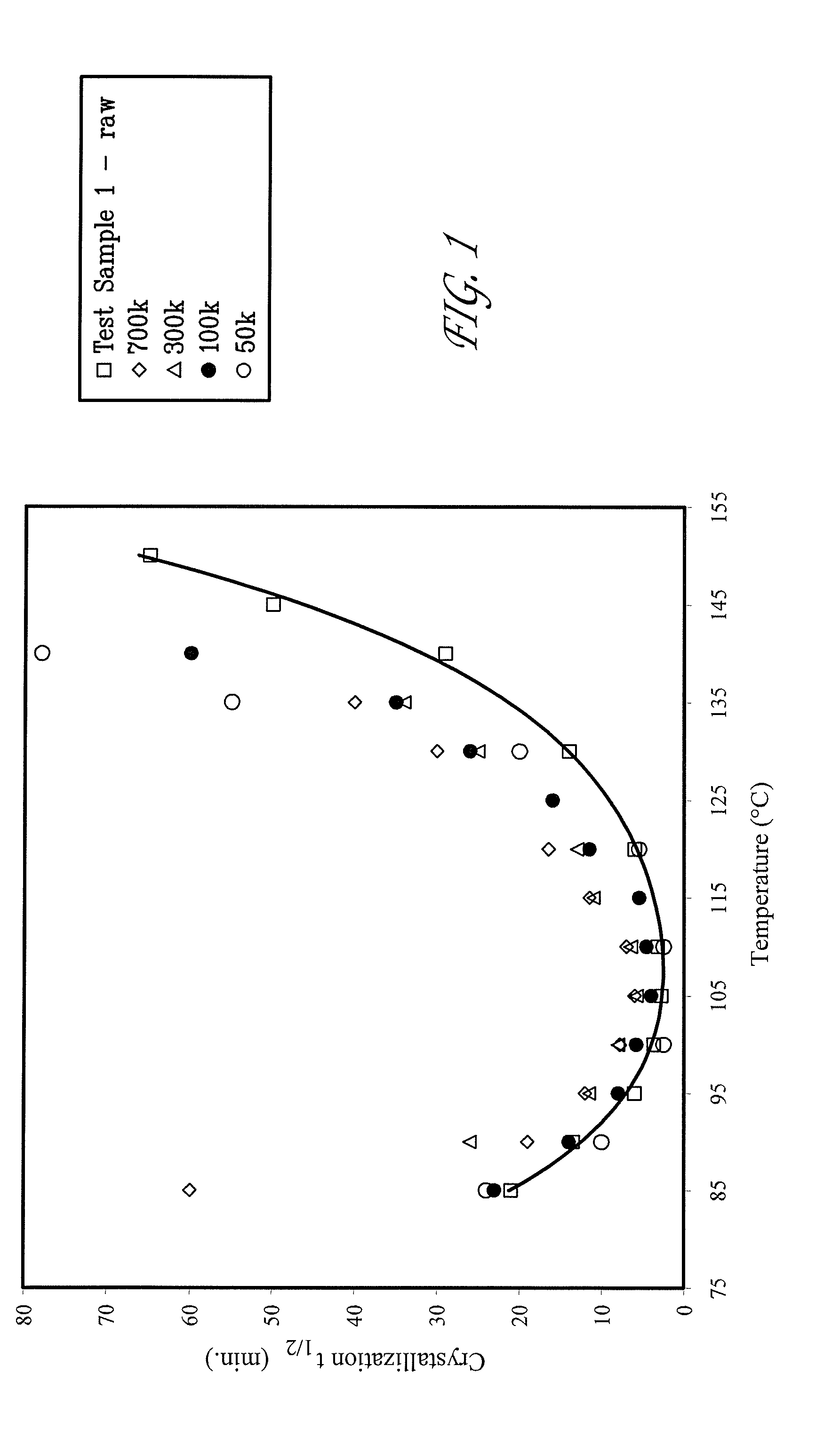Bioabsorbable polymer compositions exhibiting enhanced crystallization and hydrolysis rates
a bioabsorbable and polymer technology, applied in the field of bioabsorbable polymer compositions, can solve the problems of reduced quality of final products, reduced production capacity, and incomplete polymer chains cannot form single straight stems, and achieve crystallization and/or hydrolysis rates that are enhanced, kinetics and/or hydrolysis rates higher
- Summary
- Abstract
- Description
- Claims
- Application Information
AI Technical Summary
Benefits of technology
Problems solved by technology
Method used
Image
Examples
example 1
Crystallization Kinetics of PLLA Homopolymers as a Function of Different Molecular Weights
[0066]A series of PLLA homopolymers having substantially different molecular weights were examined calorimetrically. Weight average molecular weights are: 50,000 g / mol (50 k), 100,000 (100 k), 300,000 (300 k), 700,000 (700 k). The high molecular weight sample, identified as Test Sample 1, has an inherent viscosity of 7.5 g / dL, but the exact weight average molecular weight was difficult to determine. Calorimetric evaluation (by DSC) of PLLA samples after quenching from the melt, using the heating rate of 10° C. / min revealed glass transition temperatures in the range from 60 (for the lowest molecular weight material) to 64° C. (for the highest molecular weight material), and melting temperatures from 177.0 (for the lowest molecular weight material) to 183.5° C. (for the highest molecular weight material). Overall crystallinity for PLLA homopolymers, as determined by WAXD, is between 40 and 50%.
[0...
example 2
Crystallization Kinetics of PLLA Blends Exhibiting Enhanced Crystallization Rates
[0071]This example presents crystallization results for specifically designed blends of the higher molecular weight PLLA sample (Mw=300,000 g / mol, 300 k) and lower molecular weight PLLA (Mw=50,000 g / mol, 50 k), in the percent weight ratios of 300 k / 50 k for 80 / 20, 70 / 30, and 60 / 40. In general, lower molecular weight polymers are expected to crystallize faster than their higher molecular weight counterparts due to the higher mobility of their macromolecular chains in the melt phase accompanied by lesser entanglement effects. However, it was discovered that the blending of high molecular weight PLLA with its lower molecular weight counterpart resulted in much higher crystallization rates for the polymer blends examined under a wide range isothermal conditions. At the same time, important physical properties such as the glass transition temperature (Tg around 63° C.) and the melting point characteristics (...
example 3
Melt Index Calculation for PLLA Polymers at 235° C. Using Standard 3700 g Weight
[0073]Melt index, MI measurements were conducted on 50 k and 300 k monodisperse samples, as well as on various blends thereof, to investigate the effect of the addition of low molecular weight component on the melt viscosity. These data are presented in Table 1.
TABLE 1Melt Index of Selected PLLA Homopolymers and BlendsMelt Index,MI (g)Melt Index,Standard wt.MI (g)Polymer3,700 gwt. 6,600 gComments300k / 0.2523No flow induced using thestandard weight. 50k / / Flow was too fast using thestandard weight - notenough material to measure MI.300k / 50k0.0219 / / 80 / 20300k / 50k0.0374 / / 70 / 30300k / 50k0.0596 / / 60 / 40
Instrument: Tinius Olsen Extrusion Plastometer with MP987 Controller, Willow Grove, Pa.
[0074]Results from Table 1 demonstrate that, in addition to increasing the crystallizability of the polymers, blending improves the melt processability of high molecular weight polymers. The melt index of the blends systematically i...
PUM
| Property | Measurement | Unit |
|---|---|---|
| Temperature | aaaaa | aaaaa |
| Temperature | aaaaa | aaaaa |
| Temperature | aaaaa | aaaaa |
Abstract
Description
Claims
Application Information
 Login to View More
Login to View More - R&D
- Intellectual Property
- Life Sciences
- Materials
- Tech Scout
- Unparalleled Data Quality
- Higher Quality Content
- 60% Fewer Hallucinations
Browse by: Latest US Patents, China's latest patents, Technical Efficacy Thesaurus, Application Domain, Technology Topic, Popular Technical Reports.
© 2025 PatSnap. All rights reserved.Legal|Privacy policy|Modern Slavery Act Transparency Statement|Sitemap|About US| Contact US: help@patsnap.com



